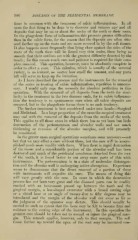Page 970 - My FlipBook
P. 970
980 DISEASES OF THE PERIDENTAL MEMBRANE.
tions in common with the treatment of calcic inflammations. In all
cases the first thing to be done is to discover and remove any and all
deposits that may be on or about the necks of the teeth or their roots.
In the phagedenic form of inflammation this presents greater difficulties
than in the calcic form, for the reason that the deposits are often situ-
ated farther up on the roots and are more covered in by the soft tissues.
It also happens more frequently that lying close against the sides of the
roots of the teeth there will be found very thin scales, these being so
smooth that their outlines are with the greatest difficulty detected by the
touch ; for this reason much care and patience is required for their com-
plete removal. This operation, however, must be absolutely complete in
order to effect a cure. This calculus, wdiich is usually of the serumal
variety, is an irritant, no matter how small the amount, and any parts
left will serve to keep up the irritation.
As I have described the process and the instruments for the removal
of the scales in treating of calcic inflammations, repetition is unneces-
sary. I would only urge the necessity for absolute perfection in this
operation. With the removal of all deposits from the teeth the simi-
larity in the treatment in the two diseases ends, for in calcic inflamma-
tion the tendency is to spontaneous cure when all calcic deposits are
removed, but in the phagedenic forms there is no such tendency.
The further treatment is best considered under two heads—Surgical
and Medicinal. In a large proportion of the cases the surgical treatment
may end with the removal of the deposits from the necks of the teeth.
This applies to all those cases in which there has as yet been but little
destruction of the pericementum and alveolar walls and not much
thickening or eversion of the alveolar margins, and will presently
be considered.
In the graver cases surgical operations sometimes seem necessary—not
but that we may effect a cure without them, but the cure will be accom-
plished much more readily with them. When there is rapid destruction
of the tissue and a considerable portion of the alveolar wall has been
destroyed and much of the peridental membrane detached from the root
of the tooth, it is found better to cut away some parts of this with
instruments. The pericementum is in a state of molecular disintegra-
tion and the alveolar wall is undergoing active absorption. Experience
seems to demonstrate that the direct removal of a portion of these
with instruments will expedite the cure. The means of doing this
will vary greatly with the case. In cases in which the destructive
process has not been very great and the diseased parts can be readily
reached with an instrument passed up between the tooth and the
gingival margin, a hoe-shaped excavator with a broad cutting edge
or a chisel bent at an angle of twenty-five to fifty degrees may be
introduced and the margin of the alveolar wall cut away as far as
the judgment of the o])erator may dictate. This should usually be
carried to such an extent that the bone may be felt to become firm and
resistant to the cutting edge of the instrument. In this operation the
greatest care should be taken not to wound or injure the gingival mar-
gin. This remark applies, however, only to that margin. The soft
tissue farther up toward the apex of the root may be lacerated con-


